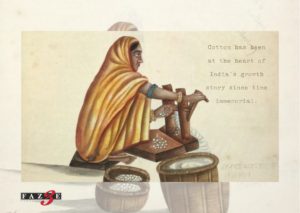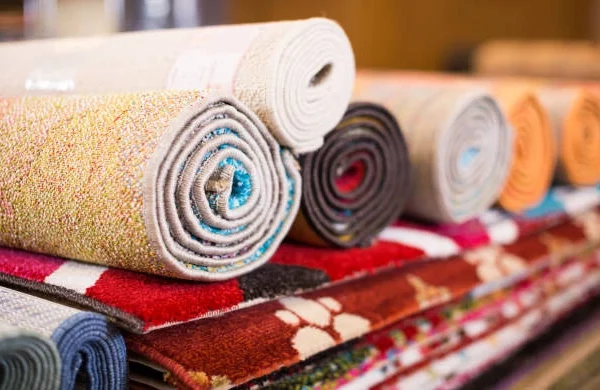Cotton is the hero of India and her place in the world. On the 74th Indian Republic Day, we celebrate the story of India through the story of her historically most popular export.

A woman cotton ginning 1815 -1820 approx.
Faze3 exports cotton-based home textiles and we know the demand for well-made Indian products in the world of fabrics. A deeper look at Indian history tells us that this demand isn’t new. Cotton has been at the heart of India’s growth story since time immemorial.
By 3000 BCE, the ancient Indus Valley civilization started cultivating cotton. A collection of religious hymns and texts unearthed from 1500 BCE reflects how much the natives revered and celebrated cotton. The threads were powering their ancient empire already.
For 3000 years (1500 BC to 1500 AD) India held monopoly over the manufacturing of cotton textiles across the discovered world.
The Gods favoured India with a climate perfect for growing cotton and we grew it and traded it forward for spices and other goods. It served as the medium of exchange that created a golden age for the diaspora within our natural boundaries.
The Greek Histories Herodotus called Indian Cotton ‘a wool exceeding in beauty and goodness to that of sheep.’ The armies of Alexander the Great swapped their woolen clothes for garb made of Indian cotton and historical texts reflect India’s thriving cotton trade with the Arab world.
In the middle-ages we began exporting it to European markets and the Eastern civilizations as well. Tales of Indian silks and fabrics made their way across international trade water routes along with bales of fabric, ready to be turned into carpets, clothes, and useful items.
Over centuries, dynasties flourished and faded but cotton production and export kept growing. Harvests saw the rise and fall of the Mauryas, Moghuls, and many rulers, till finally the East India Company reshaped modern Indian history forever.
On British trading ships came engineers who guided the rapid set up and mechanism of Indian cotton production. Labour was harnessed and mills were established to ensure constant production of the thread, to meet the demand of the British Empire.
Industrialization was a force that took over the Indian horizon. The first cotton mill set up near Kolkata in 1818 didn’t succeed commercially but the seaport of Bombay (Mumbai) showed more promise.
A mill set up in the heart of the cosmopolitan city, by Cawasjee Nanabhoy Davar in 1854, is said to be the precursor of a successful modern textile industry in the country.
Thereafter, Western India became the hub for production, with mills set up everywhere to help the British strengthen its hold on Indian purse strings.
The raw cotton fibre would leave Indian shores, leaving weary workers in its wake and return as finished products from western shores. Furthermore, these were then being sold at exorbitant prices to the same communities that had toiled to produce them.
Indian artisans who had woven rugs and stitched cotton bags were rendered jobless as factories in other British colonies took over their craft.
This angered the Indians and cotton truly was at the heart of the Indian struggle for Independence.
Leaders everywhere added the injustice within the cotton trade to their fiery speeches and roused the anger of the locals.
Mahatma Gandhi started a movement to bring the focus back on Indian textiles. The Charkha (the spinning wheel) became more than a tool to create fabric from cotton fibre. It became a symbol of longing to gain back control over our most beloved Indian product.
Everywhere Indian freedom fighters spun yarn. With each turn of the wheel, the sound of cries for Independence grew louder and louder.
In the crowded streets of Calcutta and Bombay and the villages in central India, Khadi, a fabric that represented India’s cotton spinning skills was being made and worn.
In 1922, cotton entered politics with the blessings of the great Mahatma, who urged the Indian National Congress (INC) to start a khadi department. Finally, this gave rise to the All-India Khadi Board (AIKB) and in 1925, the All-India Spinner Association (AISA).
All this cotton was weaving new threads into the fabric of the Indian economy. This destabilised the British hold over the empire’s survival in India.
After that, members of India’s political diaspora paid their dues in yarn, Indians across the nation adopted indigenous fabrics for their daily needs, giving less power to the British traders.
Eventually, after a long and passionately fought struggle, India gained her freedom. At the centre of the struggle was a visible hand of cotton.
Today, Indian home textiles and cloth exports are still at the top of the global food chain, but nothing would have been possible without the wonderous stories of how cotton built, broke and rebuilt our nation.
Happy Republic Day to everyone!

